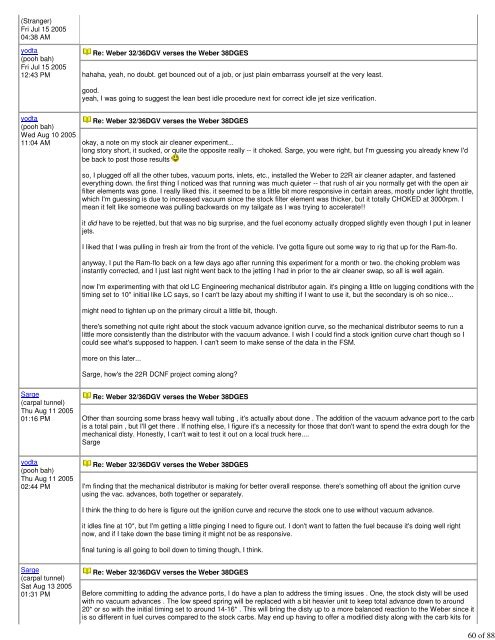You also want an ePaper? Increase the reach of your titles
YUMPU automatically turns print PDFs into web optimized ePapers that Google loves.
(Stranger)<br />
Fri Jul 15 2005<br />
04:38 AM<br />
yodta<br />
(pooh bah)<br />
Fri Jul 15 2005<br />
12:43 PM<br />
yodta<br />
(pooh bah)<br />
Wed Aug 10 2005<br />
11:04 AM<br />
Sarge<br />
(carpal tunnel)<br />
Thu Aug 11 2005<br />
01:16 PM<br />
yodta<br />
(pooh bah)<br />
Thu Aug 11 2005<br />
02:44 PM<br />
Sarge<br />
(carpal tunnel)<br />
Sat Aug 13 2005<br />
01:31 PM<br />
Re: <strong>Weber</strong> <strong>32</strong>/<strong>36DGV</strong> <strong>verses</strong> <strong>the</strong> <strong>Weber</strong> <strong>38DGES</strong><br />
hahaha, yeah, no doubt. get bounced out of a job, or just plain embarrass yourself at <strong>the</strong> very least.<br />
good.<br />
yeah, I was going to suggest <strong>the</strong> lean best idle procedure next for correct idle jet size verification.<br />
Re: <strong>Weber</strong> <strong>32</strong>/<strong>36DGV</strong> <strong>verses</strong> <strong>the</strong> <strong>Weber</strong> <strong>38DGES</strong><br />
okay, a note on my stock air cleaner experiment...<br />
long story short, it sucked, or quite <strong>the</strong> opposite really -- it choked. Sarge, you were right, but I'm guessing you already knew I'd<br />
be back to post those results<br />
so, I plugged off all <strong>the</strong> o<strong>the</strong>r tubes, vacuum ports, inlets, etc., installed <strong>the</strong> <strong>Weber</strong> to 22R air cleaner adapter, and fastened<br />
everything down. <strong>the</strong> first thing I noticed was that running was much quieter -- that rush of air you normally get with <strong>the</strong> open air<br />
filter elements was gone. I really liked this. it seemed to be a little bit more responsive in certain areas, mostly under light throttle,<br />
which I'm guessing is due to increased vacuum since <strong>the</strong> stock filter element was thicker, but it totally CHOKED at 3000rpm. I<br />
mean it felt like someone was pulling backwards on my tailgate as I was trying to accelerate!!<br />
it did have to be rejetted, but that was no big surprise, and <strong>the</strong> fuel economy actually dropped slightly even though I put in leaner<br />
jets.<br />
I liked that I was pulling in fresh air from <strong>the</strong> front of <strong>the</strong> vehicle. I've gotta figure out some way to rig that up for <strong>the</strong> Ram-flo.<br />
anyway, I put <strong>the</strong> Ram-flo back on a few days ago after running this experiment for a month or two. <strong>the</strong> choking problem was<br />
instantly corrected, and I just last night went back to <strong>the</strong> jetting I had in prior to <strong>the</strong> air cleaner swap, so all is well again.<br />
now I'm experimenting with that old LC Engineering mechanical distributor again. it's pinging a little on lugging conditions with <strong>the</strong><br />
timing set to 10* initial like LC says, so I can't be lazy about my shifting if I want to use it, but <strong>the</strong> secondary is oh so nice...<br />
might need to tighten up on <strong>the</strong> primary circuit a little bit, though.<br />
<strong>the</strong>re's something not quite right about <strong>the</strong> stock vacuum advance ignition curve, so <strong>the</strong> mechanical distributor seems to run a<br />
little more consistently than <strong>the</strong> distributor with <strong>the</strong> vacuum advance. I wish I could find a stock ignition curve chart though so I<br />
could see what's supposed to happen. I can't seem to make sense of <strong>the</strong> data in <strong>the</strong> FSM.<br />
more on this later...<br />
Sarge, how's <strong>the</strong> 22R DCNF project coming along?<br />
Re: <strong>Weber</strong> <strong>32</strong>/<strong>36DGV</strong> <strong>verses</strong> <strong>the</strong> <strong>Weber</strong> <strong>38DGES</strong><br />
O<strong>the</strong>r than sourcing some brass heavy wall tubing , it's actually about done . The addition of <strong>the</strong> vacuum advance port to <strong>the</strong> carb<br />
is a total pain , but I'll get <strong>the</strong>re . If nothing else, I figure it's a necessity for those that don't want to spend <strong>the</strong> extra dough for <strong>the</strong><br />
mechanical disty. Honestly, I can't wait to test it out on a local truck here....<br />
Sarge<br />
Re: <strong>Weber</strong> <strong>32</strong>/<strong>36DGV</strong> <strong>verses</strong> <strong>the</strong> <strong>Weber</strong> <strong>38DGES</strong><br />
I'm finding that <strong>the</strong> mechanical distributor is making for better overall response. <strong>the</strong>re's something off about <strong>the</strong> ignition curve<br />
using <strong>the</strong> vac. advances, both toge<strong>the</strong>r or separately.<br />
I think <strong>the</strong> thing to do here is figure out <strong>the</strong> ignition curve and recurve <strong>the</strong> stock one to use without vacuum advance.<br />
it idles fine at 10*, but I'm getting a little pinging I need to figure out. I don't want to fatten <strong>the</strong> fuel because it's doing well right<br />
now, and if I take down <strong>the</strong> base timing it might not be as responsive.<br />
final tuning is all going to boil down to timing though, I think.<br />
Re: <strong>Weber</strong> <strong>32</strong>/<strong>36DGV</strong> <strong>verses</strong> <strong>the</strong> <strong>Weber</strong> <strong>38DGES</strong><br />
Before committing to adding <strong>the</strong> advance ports, I do have a plan to address <strong>the</strong> timing issues . One, <strong>the</strong> stock disty will be used<br />
with no vacuum advances . The low speed spring will be replaced with a bit heavier unit to keep total advance down to around<br />
20* or so with <strong>the</strong> initial timing set to around 14-16* . This will bring <strong>the</strong> disty up to a more balanced reaction to <strong>the</strong> <strong>Weber</strong> since it<br />
is so different in fuel curves compared to <strong>the</strong> stock carbs. May end up having to offer a modified disty along with <strong>the</strong> carb kits for<br />
60 of 88


